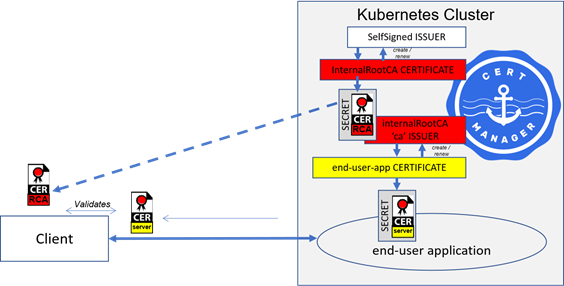Certificate Management¶
StarlingX integrates the open source project cert-manager (http://cert-manager.io), in order to provide certificate management support for end-users’ containerized applications.
Cert Manager Modes¶
Cert-manager is a native Kubernetes certificate management controller, that supports the following general modes of operation:
Interacting with External Certificate Authorities (CAs)
In this mode, a cert-manager ISSUER is configured to interact with an External CA of a particular type. External CA types supported by cert-manager are ACME, Vault or Venafi (note that StarlingX has only tested and validated cert-manager with ACME CAs).
When a cert-manager CERTIFICATE is created using this External CA ISSUER, cert-manager
creates the private key and public certificate,
sends the Certificate Signing Request to the External CA using the appropriate protocol for the type of External CA, and
responds to any challenges (as specified in the CERTIFICATE specs) from the CA
The signed certificate is made available in a Kubernetes SECRET specified in the CERTIFICATE spec.
Cert-Manager will also automatically monitor CERTIFICATE expiry dates and automatically send an updated Certificate Signing Request messages to the External CA, prior to expiry of the CERTIFICATE (as specified in the CERTIFICATE specs), in order to renew the CERTIFICATE and update the Kubernetes SECRET holding the certificate.

Providing an Internal Certificate Authority
In this mode, a cert-manager
selfsignedtype ISSUER andcatype ISSUER provides a non-challenging Root CA for signing certificates local to the Kubernetes cluster.A
selfsignedtype ISSUER is created to automatically create a private key and certificate pair for the internal Root CA.Then a
catype ISSUER is created with this generated Root CA’s private-key/certificate pair for signing.When a cert-manager CERTIFICATE is created using this Internal
caISSUER, cert-managercreates the private key and public certificate, and
simply signs the certificate with the
caISSUER’s private-key/certificate pair.
The signed certificate is made available in a Kubernetes SECRET specified in the CERTIFICATE spec.
Again, cert-Manager will automatically monitor CERTIFICATE expiry dates and automatically request the internal
caISSUER to sign an updated certificate, prior to expiry of the CERTIFICATE (as specified in the CERTIFICATE specs), in order to renew the CERTIFICATE and update the Kubernetes SECRET holding the certificate.
Combination of the above two modes
For example in a particular RootCA - IntermediateCA - Server certificate chain,
The RootCA ISSUER in cert-manager could be of type
acmefor requesting the IntermediateCAs certificate from an external ACME CA,While the IntermediateCA ISSUER in cert-manager could be of type
cafor signing the server certificates based on the intermediateCA certificate (from the external ACME CA).
Using Cert Manager CERTIFICATES in your Application¶
How CERTIFICATEs (and their TLS type SECRETs) are created and integrated into an end-user’s application depends on how the end-user has chosen to expose its service externally. There are typically two options:
The end-user’s application uses ingress controller to expose its service (the most common approach)
In this scenario, the end-user’s application uses StarlingX’s integrated nginx ingress-controller to both originate/terminate the HTTPS connection as well as deal with cert-manager for requesting the required CERTIFICATE.
Specifically, in this scenario, the end-user’s application’s helm chart or yaml file must
create an INGRESS object that
specifies the details on ingress forwarding based on the URL (hostname, port and path), and
specifies
TLSmode along with cert-manager -specific annotations for details on creating the CERTIFICATE for this ingress connection with cert-manager; minimally the cert-manager ISSUER to use must be specified.
Nginx Ingress Controller will automatically detect when cert-manager renews the server certificate and update its HTTPS connection to use the new certificate.
The end-user’s application does not deal with HTTPS or certificates at all.
The end-user’s application exposes its service with a NodePort and originates/terminates HTTPS itself
In this scenario, the end-user’s application is originating/terminating HTTPS on its own, so it needs access to the Kubernetes SECRET holding the TLS certificate, in order to establish the HTTPS connection.
In this scenario, the end-user’s application’s helm chart or yaml file must
create the CERTIFICATE (referencing the desired ISSUER to use, and indicating the SECRET to store the certificate in),
include the SECRET as a mounted volume in the pod spec
such that the application’s container can access the TLS certificate as a PEM file for use in establishing the HTTPS connection.
Note that in this scenario, the application’s container must detect when the mounted SECRET file changes due to cert-manager auto-renewing the CERTIFICATE (and the associated SECRET), and update its HTTPS connection to use the updated certificate.
See also
See External CA and Ingress Controller Example section for an example of how to configure an application to use Ingress Controller to both expose its TLS-based service and to use an External CA for signing CERTIFICATEs.
See Internal CA and NodePort Example section for an example of how to configure an application to use NodePort to expose its self-managed TLS-based service and to use an Internal CA for signing CERTIFICATEs.
